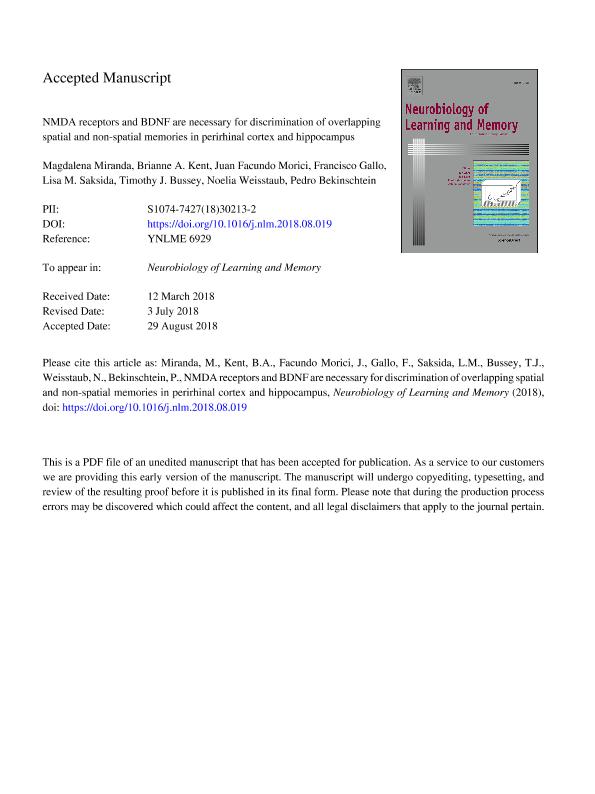Artículo
NMDA receptors and BDNF are necessary for discrimination of overlapping spatial and non-spatial memories in perirhinal cortex and hippocampus
Miranda, Magdalena ; Kent, Brianne A.; Morici, Juan Facundo
; Kent, Brianne A.; Morici, Juan Facundo ; Gallo, Francisco Tomás
; Gallo, Francisco Tomás ; Saksida, Lisa M.; Bussey, Timothy J.; Weisstaub, Noelia V.
; Saksida, Lisa M.; Bussey, Timothy J.; Weisstaub, Noelia V. ; Bekinschtein, Pedro Alejandro
; Bekinschtein, Pedro Alejandro
 ; Kent, Brianne A.; Morici, Juan Facundo
; Kent, Brianne A.; Morici, Juan Facundo ; Gallo, Francisco Tomás
; Gallo, Francisco Tomás ; Saksida, Lisa M.; Bussey, Timothy J.; Weisstaub, Noelia V.
; Saksida, Lisa M.; Bussey, Timothy J.; Weisstaub, Noelia V. ; Bekinschtein, Pedro Alejandro
; Bekinschtein, Pedro Alejandro
Fecha de publicación:
11/2018
Editorial:
Academic Press Inc Elsevier Science
Revista:
Neurobiology of Learning and Memory
ISSN:
1074-7427
Idioma:
Inglés
Tipo de recurso:
Artículo publicado
Clasificación temática:
Resumen
Successful memory involves not only remembering information over time but also keeping memories distinct and less confusable. Discrimination of overlapping representations has been investigated in the dentate gyrus (DG) of the hippocampus and largely in the perirhinal cortex (Prh). In particular, the DG was shown to be important for discrimination of overlapping spatial memories and Prh was shown to be important for discrimination of overlapping object memories. In the present study, we used both a DG-dependent and a Prh-dependent task and manipulated the load of similarity between either spatial or object stimuli during information encoding. We showed that N-methyl-D-aspartate-type glutamate receptors (NMDAr) and BDNF participate of the same cellular network during consolidation of both overlapping object and spatial memories in the Prh and DG, respectively. This argues in favor of conserved cellular mechanisms across regions despite anatomical differences.
Archivos asociados
Licencia
Identificadores
Colecciones
Articulos(INCYT)
Articulos de INSTITUTO DE NEUROCIENCIAS COGNITIVAS Y TRASLACIONAL
Articulos de INSTITUTO DE NEUROCIENCIAS COGNITIVAS Y TRASLACIONAL
Citación
Miranda, Magdalena; Kent, Brianne A.; Morici, Juan Facundo; Gallo, Francisco Tomás; Saksida, Lisa M.; et al.; NMDA receptors and BDNF are necessary for discrimination of overlapping spatial and non-spatial memories in perirhinal cortex and hippocampus; Academic Press Inc Elsevier Science; Neurobiology of Learning and Memory; 155; 11-2018; 337-343
Compartir
Altmétricas



